Electric Vehicle Batteries Degrade Over Time, Here’s Some Advice On Keeping Them In Tip Top Condition
Friday, 27. November 2020
The following article was created for large fleet users but the same advice equally applies to consumers and small companies who drive electric vehicles
How long does an electric car battery last? Use the free Geotab EV Battery Degradation Tool to compare the average battery degradation over time for different vehicle makes and model years.
Geotab developed the tool based on an analysis of 6,300 fleet and consumer electric vehicles. Read on to learn about EV battery health and get key takeaways on real-world battery performance.
See also: To what degree does temperature impact EV range?
The importance of EV batteries
If you’re thinking about buying an electric vehicle (EV), there are some important factors to consider. These three questions are probably at the top of your list:
- How much will the EV cost?
- What is its range?
- How long will the battery last?
From a life-cycle perspective, battery performance and health really are the key to it all. As the battery is an EV’s most expensive component, the degree of degradation will affect the vehicle’s residual value (which helps answer the cost question from above), and will also have a direct impact on maximum usable range over time.
See also: Podcast: EV myths and management with Charlotte Argue
How long will an EV battery last?
You might have noticed that it is tough to get a straight answer to questions about an EV’s battery lifespan. What you may find instead are assurances that batteries are covered by warranty should something go wrong. Typically, battery coverage is 8 years or 100,000 miles, but this will vary by manufacturer and country.
Warranties are reassuring, and so too is the fact that battery costs are decreasing significantly year over year. Since 2010, the price of an average Lithium-ion battery pack has dropped by over 80%.
An automaker’s guarantee of their battery technology and the promise of decreasing costs should inspire some confidence. However, most of us would find more comfort knowing how quickly our batteries are expected to degrade, and how to minimize this loss.
See also: Preparing for EVs: Charge the North EV study findings for fleet operators
What is EV battery degradation?
Battery degradation is a natural process that permanently reduces the amount of energy a battery can store, or the amount of power it can deliver. The batteries in EVs can generally deliver more power than the powertrain components can handle. As a result, power degradation is rarely observable in EVs and only the loss of the battery’s ability to store energy matters.
A battery’s condition is called its state of health (SOH). Batteries start their life with 100% SOH and over time they deteriorate. For example, a 60 kWh battery that has 90% SOH would effectively act like a 54 kWh battery.
Keep in mind, this is not the same as vehicle range (distance the vehicle can travel on those kWhs), which will fluctuate on a daily or trip-by-trip basis, depending on a number of factors including charge level, topography, temperature, auxiliary use, driving habits and passenger or cargo load.
Common factors impacting Lithium-ion battery health:
- Time
- High temperatures
- Operating at high and low state of charge
- High electric current
- Usage (energy cycles)
While there has been plenty of research done on battery health, there has been very little data following the real-world performance of EVs over time, let alone comparisons across different makes and models. Until now.
See also: J1939: Why having electric trucks and buses speak the same language is good for fleets
Introducing the EV Battery Degradation Tool
Geotab created the EV Battery Degradation Tool to assess how batteries have been holding up and to consider the relative importance of the above factors on EV battery life under real-world conditions.
We analyzed the battery health of 6,300 fleet and consumer EVs, representing 1.8 million days of data. From the telematics data processed, we have gained insight into how real-world conditions influence the battery health of electric vehicles, providing aggregated average degradation data for 21 distinct vehicle models, representing 64 makes, models and years.
Notes about the tool:
- The degradation curves displayed below are the average trend line from the data analyzed.
- These graphs can offer insight into average battery health over time, but should not be interpreted as a precise prediction for any specific vehicle.
- A subset of vehicle makes, models and years are not available in the visualization tool – we have excluded vehicles with insufficient data, so don’t be alarmed if your car of choice is missing.
Get started with the tool
For more information and to use the tool, see the Electric Vehicle Battery Degradation Tool page. To test it out, use the embedded version below:
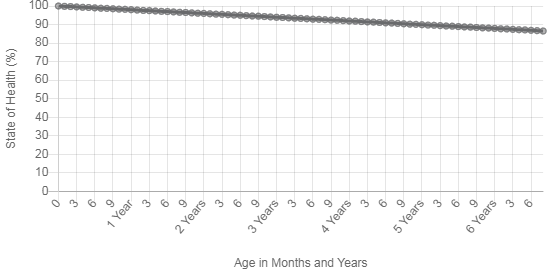
Key takeaways
High levels of sustained battery health observed
First and foremost, based on data from over 6,000 electric vehicles, spanning all the major makes and models, batteries are exhibiting high levels of sustained health. If the observed degradation rates are maintained, the vast majority of batteries will outlast the usable life of the vehicle.
Like us, health declines with age
As you might expect, the older a vehicle is, the more likely its battery has deteriorated. However, when looking at average decline across all vehicles, the loss is arguably minor, at 2.3% per year.
This means that if you purchase an EV today with a 150 mile range, losing about 17 miles of accessible range after five years is unlikely to impact your day-to-day needs.
Is EV battery degradation linear?
While this tool shows more or less linear degradation, as a general rule, EV batteries are expected to decline non-linearly: an initial drop, which then continues to decline but at a far more moderate pace. Towards the end of its life a battery will see a final significant drop, as seen below.
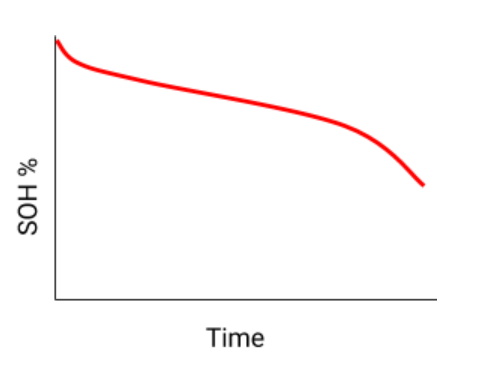
Figure 1: A normal degradation curve is expected to look something like this.
Fortunately for the drivers, too few batteries we’ve observed have reached the end-of-life drop for us to predict at what point this is likely to occur. We will continue to monitor to see when the non-linear degradation (also known as the “heel”) begins.
There is a measurable difference between makes, models and years
From our data, it appears that vehicle batteries respond differently to the test of time, depending on their make and model-year. Why do some vehicle models seem to, on average, degrade faster than others? Two potential contributors are battery chemistry and thermal management of the battery pack.
While EVs use Lithium-ion batteries, there are many different variations of Lithium-ion chemistries (the most prominent difference being the materials used for the electrodes). A battery’s chemical make-up will influence how it responds to stress. In addition to cell chemistry, temperature control techniques differ across vehicle models. A major distinction is if the battery pack is cooled and/or heated by air or by liquid.
Let’s compare a vehicle with a liquid cooling system to one with a passive air cooling system: the 2015 Tesla Model S and the 2015 Nissan Leaf, respectively. The Leaf has an average degradation rate of 4.2%, while the Model S is 2.3%. Good thermal management means better protection against degradation.
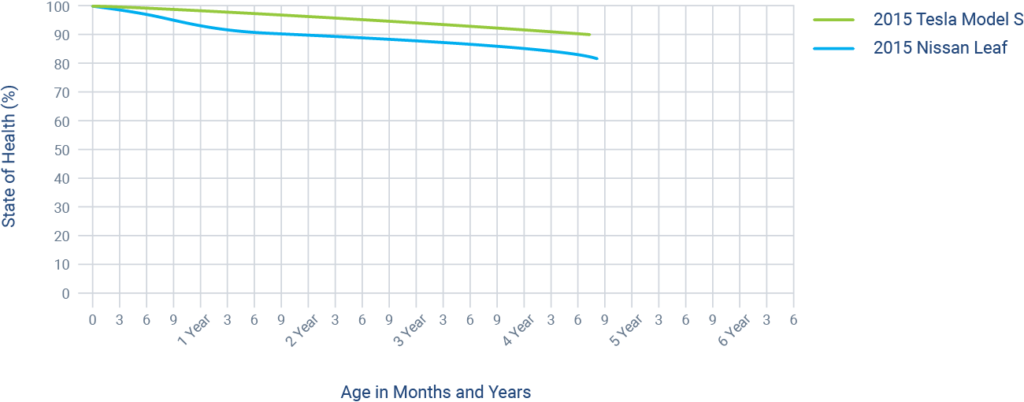
Figure 2: Battery degradation comparison of the 2015 Tesla Model S (liquid cooling) vs. the 2015 Nissan Leaf (passive air cooling).
State of charge (SOC) and the buffer effect
Another anticipated reason for the differences in battery health between manufacturers is how SOC is controlled. Operating a battery at near full or empty has implications on battery health. To limit this effect, many manufacturers add a buffer, effectively preventing access to the extreme ends of the SOC window (shown in the image below).
In addition to the protection buffers at the top end and bottom end of the battery range, many vehicles provide the EV owner the option to stop normal daily charging at a level below 100%.
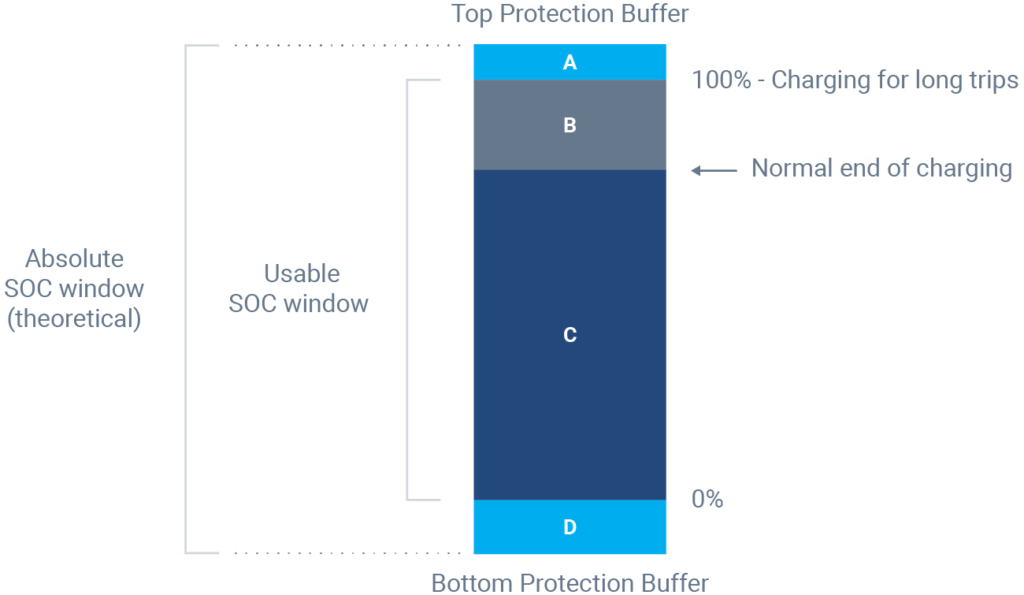
Figure 3: Battery protection buffers control the usable state of charge window for an EV.
Did you know?
Removing the extremes is not only done for battery health but also for safe vehicle operation. At the extreme ends the battery wouldn’t be able to accept or deliver full power and the driving experience would be impacted. In essence, a battery at 100% isn’t completely charged from a pure battery chemistry standpoint.
Similarly, 0% isn’t completely empty. Since the vehicle owner is unable to access these parts of the battery range for safety and battery life reasons, it is likely that many are unaware of it.
Thanks to over-the-air software upgrades, it’s possible that the size of the buffer can change over time, as discovered by some Tesla owners in 2019 when they noticed a decrease in their top range. Tesla confirmed the upgrade was “to protect the battery and improve longevity.”
In addition, some automakers have adjustable charge ceilings, where the user can pre-set at what point the battery stops charging (e.g., they can tell the vehicle to stop charging at 75% instead of 100%).
This owner-discretionary region (B in the graphic above) works in combination with the non-discretionary buffer (A) to limit battery operation in areas of higher degradation. In later updates to the degradation tool we intend to include the impact of owner’s operation within this discretionary (B) region and the resulting impact on degradation rates.
Let’s consider an example:
The Chevrolet Volt, especially the early model years, has comparatively large top and bottom protection buffers (regions A and D) that dynamically change as the battery ages. While the larger buffers mean less energy for driving, it should result in a longer lasting battery pack.
Given the larger SOC buffers, liquid thermal management, and dynamic (decreasing) buffer size, slower than average degradation rates should be expected on the Volt.
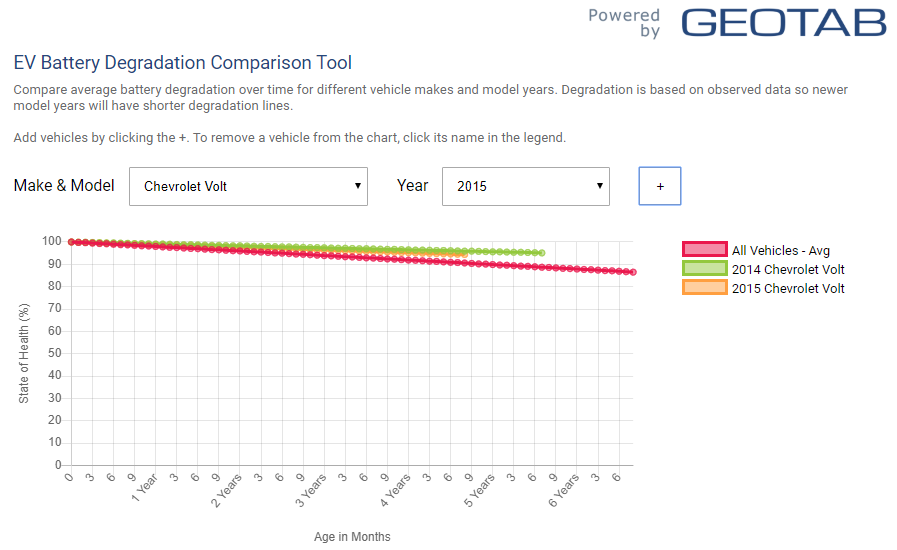
Figure 4: Battery degradation over time for a Chevrolet Volt vs. all vehicles.
What additional factors appear to influence battery health?
Based on the telematics data available, we were able to evaluate battery degradation by different factors the vehicles were exposed to and see if there was any correlation with health decline. These factors included:
- Use
- Extreme climates
- Charging type
Over time, we hope to develop these insights into a degradation tool that can better predict EV state of health.
High vehicle use does not equal higher battery degradation
One exciting piece of information we were able to glean from the data was that vehicles with high use did not show significantly higher battery degradation. This should come as welcome news, since you don’t get the benefit of an EV if it’s just sitting in the fleet yard.
The takeaway? Don’t be afraid to put your EVs in high-use duty cycles. As long as they are within their daily driving range, their battery life won’t be negatively impacted.
One caveat: if high use requires routine DC fast charging, be sure to read the section on the impact of charging type.
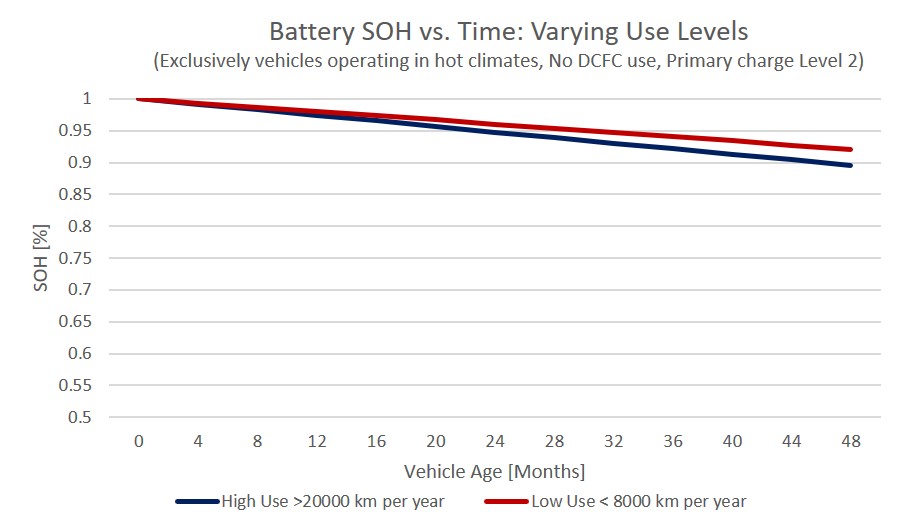
Figure 5: Amount of use doesn’t appear to have much impact on degradation rates.
Vehicles driven in hot temperatures show faster decline in battery SOH
A battery exposed to very hot temperatures will be prone to more damage, but by how much? Will an EV in Arizona have a different battery life than the same car driven in Norway? To find out, we grouped the vehicles based on the following climate conditions:
- Temperate: Fewer than 5 days per year over 80 F (27 C) or under 23 F (-5 C).
- Hot: More than 5 days per year over 80 F (27 C).
As illustrated below, vehicles driven in hot climates showed a notably faster rate of decline than those driven in moderate climates. This is not great news if you and your fleet toil under the hot sun.
Heat and cold weather also impacts your day-to-day range. To understand how, take a look at our Temperature Tool for EV Range.
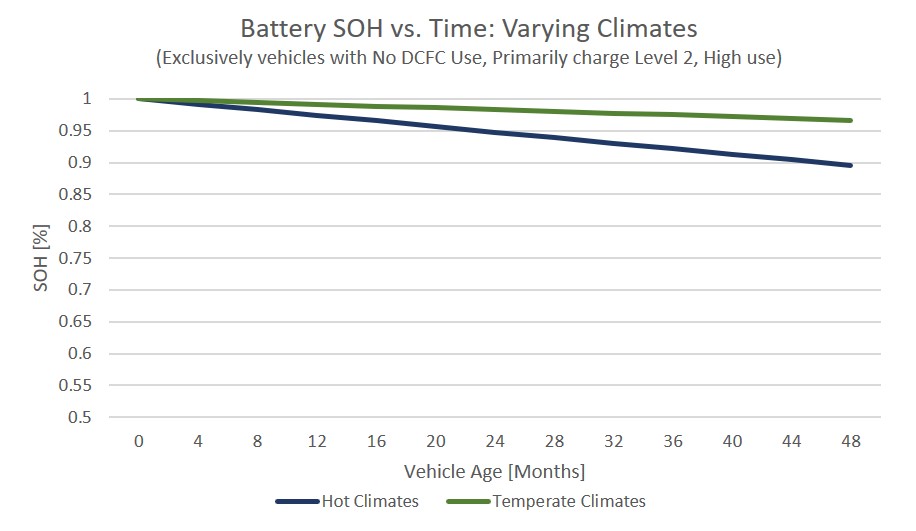
Figure 6: Batteries exposed to hot days degrade faster than those in temperate climates.
Taking a look at charge type
We were able to look at the predominant charging level used for the EVs in our system. North American EV charging stations are categorized in three common types:
- Level 1: 120 volt – a regular home outlet in North America.
- Level 2: 240 volt – typical for home or fleet charging.
- Direct current fast charger: DCFC – for faster top ups.
For an overview of charging and related costs, read our simple guide to EV charging.
Charging in most of Europe is referred to as AC charging (which is generally equivalent to Level 2 in North America) and DC charging (DCFC, as described above).
While Level 2 is often cited as the optimal way to charge an EV, the difference in battery health between cars that routinely charged on Level 2 as compared to those who used Level 1 appeared to be observable but was not beyond the level of statistical significance.

Figure 7: Battery degradation for vehicles that primarily charge on Level 1 compared with Level 2.
The use of DCFCs, however, does appear to impact the speed that batteries degrade. Rapidly charging a battery means high currents resulting in high temperatures, both known to strain batteries. In fact, many automakers do suggest limiting the use of DCFC in order to prolong their vehicles’ battery life.
Here we look at all battery electric vehicles in the same climate group (we chose to look at the most susceptible group – those operating in extreme climate conditions), and categorized them based on how frequently they used a DCFC: Never, occasionally (1–3 times per month) and frequently (more than 3 times per month).
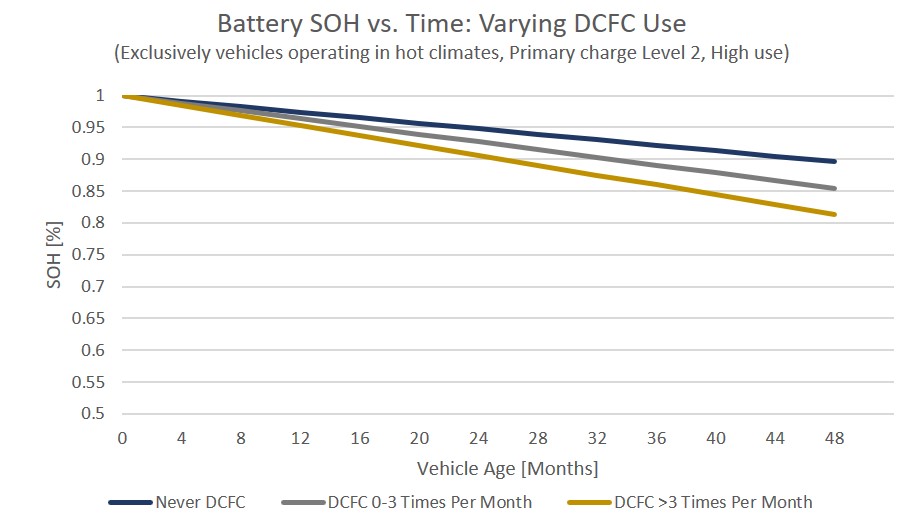
Figure 8: Battery degradation appears to be strongly correlated with DCFC use for vehicles in seasonal or hot climates.
The difference between those vehicles that never used DCFC and those that used it even occasionally in seasonal or hot climates was notable. While there may be other factors at play (we want to stress that this wasn’t a controlled experiment), charging via lower power Level 2 charging should be prioritized.
Tips to prolong your EV battery’s life
While battery degradation varies by model and external conditions – such as climate and charging type – the majority of vehicles on the road today have not experienced significant decline. In fact, overall degradation has been very modest, with an average capacity loss of just 2.3% per year. Under ideal climate and charging conditions, the loss is 1.6%.
While some things are out of an operator’s control, there are ways you can extend the life of your EV’s battery.
Some tips for operating your EVs:
- Avoid keeping your car sitting with a full or empty charge. Ideally, keep your SOC between 20–80% particularly when leaving it for longer periods, and only charge it fully for long distance trips.
- Minimize fast charging (DCFC). Some high-use duty cycles will need a faster charge, but if your vehicle sits overnight, level 2 should be sufficient for the majority of your charging needs.
- Climate is out of an operator’s control, but do what you can to avoid extreme hot temperatures, such as choosing shade when parked on hot days.
- High-use is not a concern, so fleets shouldn’t hesitate to put them to work. An EV isn’t useful sitting idle in the fleet yard, and putting on more miles per vehicle is overall a better fleet management practice.
Final thought
Don’t sweat the small stuff. As vehicles come out with larger battery packs, losing some capacity may not impact your day-to-day driving needs, and shouldn’t overshadow the many benefits EVs have to offer. By Graham Hill thanks to Geotab






















